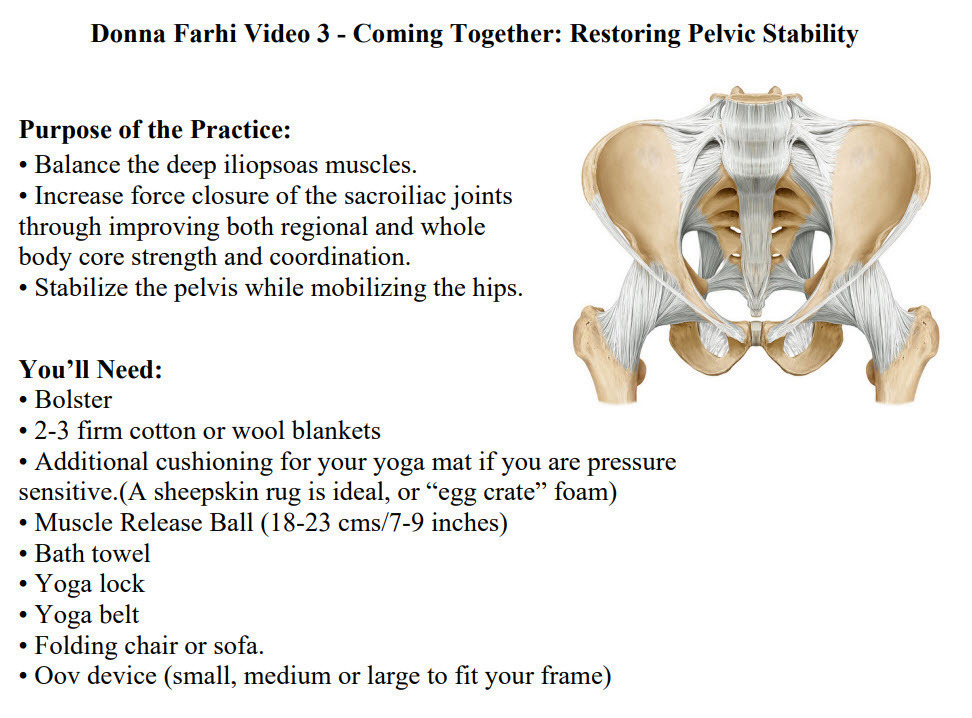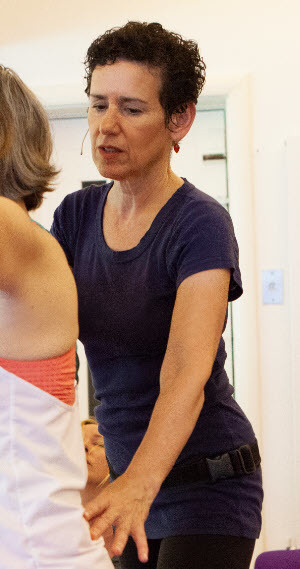Discover My Protocol For
Yoga Teachers With Sacroiliac Pain
To Restore Stability And
Move With Ease
Chronic or intermittent sacroiliac pain or discomfort can both restrict your yoga practice and your life as well as challenge your teaching.
Sarah initially brushed it off. What started out as a sharp lower back twinge during practice, had sort of improved but continued to flare. Over time the discomfort persisted as a "niggling" ache, and now it had been a constant companion for five years, no matter what she did.
Being a senior yoga teacher and a qualified yoga therapist, yet not being able to fix her own nagging SIJ discomfort was very frustrating, leading Sarah to wonder if it was simply early onset age-related-degeneration ...
And that thought introduced all sorts of unanswerable questions. What was it going to be like in another five years? How long would she be able to practice without more serious pain management? How could she ethically teach practices that appeared to be causing her own instability? How much was this going to cost?
Sarah needed to continue working as a teacher but she also wanted to know which yoga practices were contributing to her problem and, more importantly, she wanted to prevent this from happening to her students. She felt frustrated that as a qualified yoga therapist she couldn't seen to shift her own SIJ instability.
Professional doubt, and fear crept in. So when an opportunity arose to model an unknown yet passive muscle balancing exercise in front of 100+ of her peers at a Yoga Therapy conference arose, Sarah volunteered.
When asked by Donna Farhi, after two 5-minute rests, lying prone on a bolster with a soft therapy ball placed under her groins, "Now stand up slowly and tell me what you feel," Sarah paused. Tears welled, then ran down her face, over a growing smile.
“It’s the first time I’ve stood still, and been comfortable in 5 years,” she said.
Yoga for Lower Back Pain:
Keys to Sacroiliac Stability And Ease of Movement
There are an estimated 14.2 million US outpatients with sacroiliac joint (SIJ) related lower back pain according to a 2014 paper published by the US National Institute of Health.*
The information in this online course could be the next step to assist in their recovery of SIJ function.
With this self-paced 13-hour online course you'll be able to work through my tested SIJ protocol that shares the anatomical and bio-mechanical basis for why many common yoga practices you love, may be inadvertently eroding your pelvic integrity. The course offers a pathway from practices that aggravate, to those that stabilize, strengthen and build pelvic integrity so you can once more begin to move with ease.
Created from more than three decades of teaching and my own recent journey of recovery from a double pelvic fracture, this course has been designed for yogis by a yogi, but with application to all people suffering with SIJ discomfort, pain or disability.
*Sacroiliac Joint Pain: Burden of Disease: Cher, Polly, & Berven: Medical Devices (Auckl) 2014; 7: 73–81. US National Library of Medicine.
Here’s What You’ll Get When You Sign Up
This pre-recorded online course delivers 13 hours of learning to binge-watch or self-pace over weeks. The course includes:
-Lifetime access to all four anatomy lectures and four videos within 48 hours.
-Transcripts and audio downloads of the four lectures and four video practices.
-Cheat sheets from each of the four video practice sessions giving you a handy reference on your mat.
Lifetime access
You can take advantage of the technology and learn at your own pace without ever feeling pressured. Rewind, pause or fast forward to the relevant section you want to study more deeply.
Practice Cheat Sheets
One set for each of the four videos to summarize the practice sequence. This means you can watch and focus on the video without needing to take notes, then use the cheat sheets to guide you on the mat. Includes the full list of props.

Click or tap to enlarge image
Flexible Learning Increases Retention
Enjoy the flexibility of online learning which studies show not only saves you 40-60% of the time required to attend live classes but also enhances retention by 25-60%.
Qualifies for 13 non-contact hours of professional development
This course qualifies for ...
-13 non-contact CEU hours with Yoga Alliance or
-13 APD hours with the International Association of Yoga Therapists
Here’s what people are saying about the course
Peter Blackaby
Yoga Teacher, Author: Intelligent Yoga
Well Thought Through and Easy to Follow
Donna Farhi has put together a deeply helpful online course for people seeking to understand the causes, ramifications and rehabilitation protocols of low back pain and sacroiliac problems. She covers the theory in depth, including a helpful review of the historical perspectives that lead up to current thinking. The practical aspect of the course is well thought through and easy to follow, I can fully recommend it.
Andrea Vehrs
Yoga Teacher, MSc, E-RYT200, RYT500
Resigned from the SIJ Club
THANK YOU DONNA! I have learned SO much and I have cut up my membership card to the SIJ Club! I have also had chronic hip pain off and on for years in my front left hip flexor . As I have been applying the principles and doing the practices I have NO MORE hip pain. Wow!
Laura Kupperman
M.A., C-IAYT
An Important Resource For All Yoga Professionals
This course is an important resource for yoga professionals who want to understand SI joint function on a deeper level, and specifically, how to create more SI joint stability for their students or themselves. Unfortunately, there seems to be more and more SI joint dysfunction among yogis, due to an overemphasis on practices that can overstretch ligaments and create discomfort. Using clear accessible language, and demonstrating a deep understanding of anatomy, Donna provides practical remedies to help us avoid and diminish SI joint pain. I highly recommend this course for yoga therapists, yoga teachers, and any movement professional who wants to provide safer teachings for their students.
What’s in the course?
Note: This course was originally delivered in four parts over four weeks to allow time for integration. However, if there is an immediate need to reduce pain, just skip ahead to the Reducing Pain and Discomfort video, but please come back to the anatomy lectures. Many students tell me that despite having "studied anatomy" they had never fully grasped the biomechanics of the sacroiliac joints and their relationship to the lower back and hips. More importantly, they were then able to see how this cognitive understanding would totally reshape their yoga practice.
1
Part One: Lectures 1 & 2
Understanding the SIJ Bones and Ligaments
Anatomy of the Sacroiliac Joints
Discover the changing evolutionary relationship between the SIJ , lumbar spine and hips, and the specific anatomical features that contribute to its stability bias yet paradoxically also allow for small degrees of mobility essential for optimal movement.
Explore the impact of gender on the incidence rate of SIJ issues and why pelvic anatomical variation defines movement ability differences between yogis and not competency or skill.
Finally, we’ll investigate how unsound biomechanics can leverage into and pry apart these joints setting the stage for SIJ dysfunction.
2
Part 1: Two 1- Hour Practice Videos
Eight Things Yogis Do to Stuff-Up Their SI-Joints:
Including femoral and spinal leveraging, misguided biomechanics in standing postures, faulty transitions in flow sequences, and poor core strength coupled with hypermobility.
Reducing Pain & Discomfort:
Research shows that pain alone can contribute to ongoing poor motor control and movement dysfunction. You’ll learn a simple practice sequence for calming and alleviating sacroiliac discomfort and helping to recenter the pelvic bones. We’ll do targeted release work with the iliopsoas muscles, gently mobilize the pelvis and lumbar spine, and learn to adapt practices to prevent excessive loading into the SIJs. We’ll also look at prop considerations that can make a big difference for those with pelvic discomfort.
3
Part Two: Lectures 1 & 2
Understanding the SIJ Musculature and Movement
Kinesiology of the Sacroiliac Joint & Models for Optimal Movement Function
Covering the historical development of Panjabi’s Spinal Stability System, Vleeming and Lee’s Integrated model for joint function and Hoffman & Gabels’ “Stability to Express Movement” theorem. These models give us a platform to understand why optimal movement cannot be attained through isolated core strength alone.
Startling new meta-analysis studies are revealing that training stability in isolation does not offer long-term relief in people with lower back pain.
We’ll look at how stability and mobility systems of the skeleton and ligaments, muscles, fascia and tendons, and the coordination of movement through the nervous system form an interdependent relationship.
Building on this we’ll investigate the intimate relationship between the “mobility-designed” hip joint, and the “stability-designed” sacroiliac joint and how these structures can be affected by common yet misguided alignment cues and “hip-opening” strategies. By understanding the movements of nutation, counternutation, and the unique action that twisting places on the SIJs, we’ll build a protocol for recovery of movement function starting with the safest movements, building towards more challenging but necessary movements, and identifying the movements most challenging to the SIJs (that may have limited usefulness for everyday living).
4
Part Two: Two 1- Hour Practice Videos
Coming Together: Building Pelvic Integrity
This practice protocol focuses on reducing asymmetrical torque in the SIJs caused by muscular imbalances, and progresses towards strengthening both core and global body tone and movement coordination to stabilize the pelvis and reduce SI-joint translation.
Many people who suffer from chronic or intermittent SIJ discomfort falsely believe that further stretching will alleviate their discomfort, only to discover that within hours the pain has worsened. Although counter-intuitive, increasing force closure of the SIJs (the snugness of the joint offered through increased regional muscular support) can often give surprising reductions in pain both immediately after practice and in the long term.
Donna will also share some unique sequences she has developed that have radically improved her pelvic stability and improved the depth of stance, speed and balance of walking (an activity that for many people exacerbates their SIJ discomfort). This pelvic integrity practice is a simple, accessible practice that may become your lifelong friend.
Maintaining Stability While Regaining Mobility
Restoring pelvic stability often involves limiting practice to linear, sagittal planes of movement (neutral, flexion and extension) and, for a period of time, avoiding movements that challenge SIJ stability.
Our everyday activities, however, require that we be able to move safely and effectively in multiple planes—rotating, spiraling, changing levels, and using our limbs in an asymmetrical fashion.
This practice sequence begins with a standing warming and loosening sequence to improve fluidity in the spine.
We’ll then explore strategies for maintaining stability while increasing mobility and function: reintroducing asymmetrical practices such as lunges, wider-stance standing postures, and twists. Many of the variations offered can be incorporated into your Yoga classes to help your students avoid future SIJ problems.
Bonus
Enrol now and enjoy these bonuses!
Ten Video Summaries
There's over 60 minutes of summary teaching in this bonus.
When the SIJ course was first released Donna created a series of ten promotional videos that were only available for 30 days.
Most videos are 5 - 10 minutes long: bite-sized info-chunks that cover a key issue in more detail than the course.
Ideal as a teaching resource or quick refresher.
Lifetime Access.
Three New Videos
These three videos were created in response to common questions that arose after the course was first released.
In 20 minutes Donna covers three important issues:
1. Undoing Hips Square to the Front
2. Anchoring the Feel of Pelvic Stability
3. Blocks, Bridges and Sacroiliac Pain
Lifetime Access.
About The Course Teacher,
(Donna Farhi)
Donna Farhi is a Yoga teacher who has been practicing for over 40 years and teaching since 1982. As a post-lineage pioneer, Donna has been at the forefront of generating a new model for teaching and practice that fosters self-inquiry through the cultivation of each person’s inner reference system. Going beyond the archaic pedagogic model that is characterised by “Simon Says” mimicry and rigid formulaic methodology, her approach is to create a safe learning environment where her students can investigate, adapt and evolve their practice to honor their individual needs.
Incorporating the rigorous backing of anatomical principles for safe and sustainable practice, Donna offers progressive levels of engagement that allow people of all levels of experience and from all traditions to build their own authentic Yoga practice. .
Considered the “teacher of teachers” students return to Donna’s intensives year after year to be a part of the inspiring evolution of Donna’s own practice and teaching.


Here’s what people are saying about the course instructor
Adrienne Lewsam
Author, Yoga and Meditation Teacher
Donna is a Master Presenter and Educator
I came with no expectations – only experience of past workshops with other accomplished teachers who mostly structured the lessons around asana. In contrast, this blitzed all!! Donna is a master presenter and educator. The information given, powerful and instantly useful, delivered in a well measured series for ease of understanding.
Carol Stall
Yoga Teacher
Simply the Best of the Best
Donna’s work is of the highest integrity, cohesion and value I have ever found in 37 years of my Yoga path. Simply the best of the best.
Kelly Elizabeth Fox
Yoga Teacher
Taking the Concepts Far Beyond Standard Textbooks
Donna’s teaching has greatly increased my understanding of biomechanics and human movement, taking the concepts far beyond standard health science textbooks. Applying this knowledge to yoga creates a profound awareness of subtle changes and possibilities within the human body and spirit. Above all, I really appreciated Donna’s grounded, practical approach to yoga and teaching.
No matter what your Yoga style or philosophy, a full understanding of individual anatomical variation and posture driven bio-mechanical strain is essential to prevent, manage or resolve sacroiliac dysfunction for yourself and your students.
Many people with early SIJ dysfunction tolerate or attempt to self-manage their situation with or without medication. If the problem persists, they may seek medical support from chiropractors, osteopaths, physical therapists, from acupuncturists or other medical professionals and may get some relief. The average chiropractor adjustment cost $115 in the US (2019).*
With yogis in particular, unless there is exploration of the problem's root cause and a connection is made with aspects of the very practice they love and live by, the dysfunction persists and over time degradation may follow. Many of the yoga practices that cause sacroiliac dysfunction can also degrade the lower back and hips. Double hip replacements are becoming surprisingly common in yoga teachers.
Over the last three decades I'm seeing more and more students with persistent SIJ dysfunction and often receive requests for help. Lower back pain related to SIJ dysfunction is increasing.
This course is designed to help you identify the possible root causes of your SIJ instability and to give you the tools to adapt your yoga practice to regain stability and increase mobility.
You can review the 13-hours of course material as often as you like and once you've learned the practices from the video sessions you can use the practice pdf sheets to guide your on-the-mat sessions.
Disclaimer: This course does not constitute or substitute for professional medical advice.
*How Much Does A Chiropractic Treatment Cost? https://chiropractorglendaleaz.com/blog/much-chiropractic-care-cost/

100% Satisfaction Guarantee for 15 Days
If you are not satisfied, then neither are we.
You have 15 days to explore the course in full and if you decide that it is not what you expected or does not meet your expectations, simply notify us and we'll refund your purchase.
No questions asked and you can keep access to the 80 minutes of bonus videos.
Don’t wait! Look at what past students have to say about this course
Sula Blake
Yoga Practitioner
Ground Breaking Work
Donna is doing such ground breaking work, I am quite sure one day her protocols will be the internationally recognized gold standard for treating the lower back - and not just in yoga practitioners. I could literally feel the subtle placement alteration in my body the day after the workshop - my movement was more free and more comfortable. Thank you.
Rose Kress
Director, ERYT500, C-IAYT, LEYE, YACEP
Put the Anatomical Wisdom Into Action with Tips to Avoid Common Mistakes
This course is a MUST for any yoga teacher or practitioner. Donna Farhi has compiled an abundance of information to keep students safe and strong in yoga classes. The detailed information about your pelvic structure is presented with clarity and precision. Farhi is at the leading edge of the new trend to keep you body safe while practicing yoga. Upon completion of this course, you will know why we need to protect our sacroiliac joint and why we need to stop the excessive stretching that has become commonplace in yoga. More than Power Points with lecture, Farhi provides practice sessions where you can put the anatomical wisdom into action with tips to avoid common mistakes that many of us make in yoga classes. I cannot say enough about how much I enjoyed this course and how simple it was to integrate the information and tools provided. Do not miss this opportunity have happier sacroiliac joints and a life filled with more ease of movement.
Frequently Asked Questions
Is course access released in stages?
Is a certificate provided with the course to claim professional education credits?
Can the videos be downloaded?
Does Donna offer one-on-one health consultations?
Help stop sacroiliac joint suffering
The demand for this knowledge far outstrips my ability to deliver it personally.
What could be even more important is offering caring guidance for people to integrate this into their lives.
For both yogis and non-yogis this is the sea-change required.
By surrendering mis-guided beliefs and bio-mechanically unsound yoga practice and through building safe practice sequences on top of a foundation of self-inquiry, perhaps together, we can reverse the declining health statistics around sacroiliac function.
Sending care,
Donna Farhi

